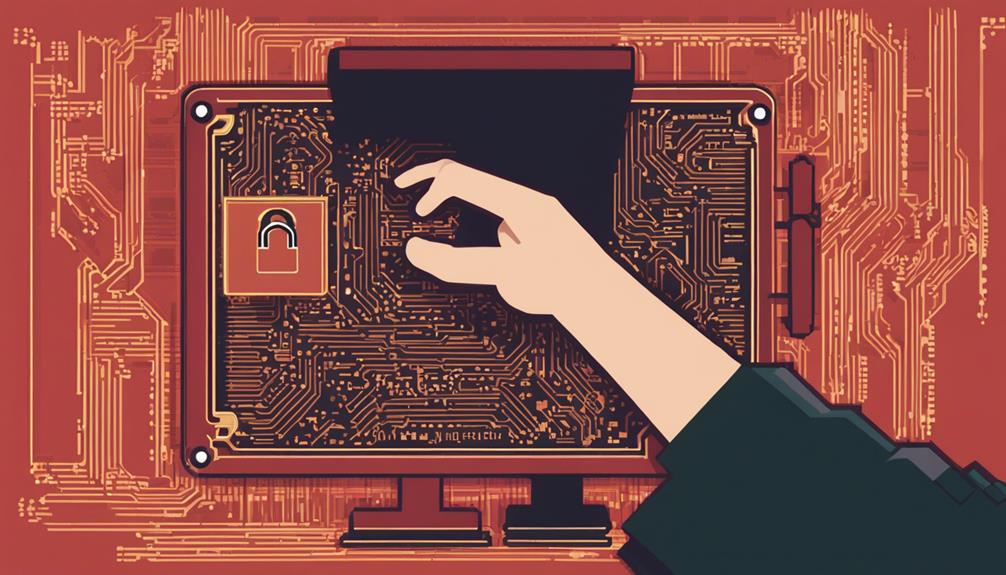Insider threats can seriously compromise your organization, as 60% of data breaches originate from within. To prevent these breaches, monitor employee activities, enforce strict access controls, and foster a proactive security culture. Make sure your team understands the importance of reporting suspicious behavior and receives proper training on identifying potential risks. By implementing these strategies, you create a stronger defense against insider threats. Discover more about enhancing your security posture by exploring further insights.
Key Takeaways
- Implement employee monitoring strategies to track data access and identify unusual patterns, preventing potential breaches before they occur.
- Enforce access controls and a least-privilege policy to limit sensitive data exposure only to necessary personnel.
- Foster a strong security culture through regular training, empowering employees to recognize and report suspicious behavior.
- Regularly review and update access rights, promptly revoking access when roles change or employees leave to mitigate vulnerabilities.
- Combine proactive security measures, like monitoring and education, to create a comprehensive defense against insider threats.

What if the biggest threat to your organization isn’t from outside hackers, but from within? It’s easy to focus on external threats, but insider threats can be just as damaging, if not more so. You might think your employees are your greatest asset, but sometimes, they can inadvertently or intentionally become a liability. That’s why it’s essential to implement effective strategies to mitigate these risks and protect your sensitive information.
One of the most effective ways to combat insider threats is through employee monitoring. By tracking employee activities, you can gain valuable insights into how data is accessed and used. This doesn’t mean you should invade their privacy; rather, it’s about guaranteeing that your organization’s resources are being handled appropriately. Monitoring can reveal unusual access patterns or unauthorized data transfers, giving you the chance to intervene before a potential breach occurs. When employees know they’re being monitored, it often discourages malicious behavior, as they understand the consequences of their actions.
Effective employee monitoring can deter insider threats by revealing unusual access patterns and promoting accountability among staff.
Another fundamental aspect of preventing insider threats is setting up robust access controls. Not all employees need access to every piece of sensitive information. By implementing a least-privilege policy, you can guarantee that individuals only have access to the data necessary for their job functions. This reduces the risk of information falling into the wrong hands. Regularly reviewing and updating access controls can further enhance your security posture. If an employee changes roles or leaves the organization, ensure their access is promptly revoked to prevent any lingering vulnerabilities.
In addition to monitoring and access controls, fostering a culture of security awareness is essential. Educate your employees about the risks of insider threats and encourage them to report any suspicious behavior. When everyone is on the same page, you create an environment where security becomes a shared responsibility. Regular training sessions can empower your staff to recognize potential threats, whether they come from within or outside the organization. Furthermore, understanding the AI bifurcation can help organizations anticipate how emerging technologies might create new insider threats.
Ultimately, addressing insider threats requires a proactive approach. By utilizing employee monitoring and implementing strict access controls, you can substantially reduce the risk of breaches from within. Combine these measures with a culture of awareness, and you’ll be well on your way to safeguarding your organization’s most valuable assets. Remember, it’s not just about protecting your data; it’s about creating trust within your organization that strengthens your overall security strategy.
Frequently Asked Questions
What Are the Signs of an Insider Threat in My Organization?
Signs of an insider threat in your organization can include unusual employee behavior, like accessing sensitive data without a clear reason. If you notice employees circumventing access controls or becoming secretive about their work, that’s a red flag. Regular employee monitoring can help you spot these behaviors early. Pay attention to changes in productivity or attendance, as these could indicate potential risks to your organization’s security. Stay vigilant and proactive to safeguard your assets.
How Can I Report Suspicious Behavior Anonymously?
If you suspect something’s off, you can report it anonymously through your organization’s whistleblower program. Don’t let fear hold you back; these programs protect your identity while ensuring your concerns are heard. You’ll typically find a dedicated hotline or online form designed for anonymous reporting. Take a deep breath, gather your evidence, and submit your report. Your vigilance could protect your workplace from potential harm, making a difference without revealing who you are.
What Legal Actions Can Be Taken Against Insider Threats?
You can take several legal actions against insider threats, including pursuing criminal charges if theft or fraud occurs. Legal repercussions might involve fines or imprisonment for the offender. Additionally, your company can implement employee discipline measures, such as termination or suspension, depending on the severity of the breach. It is crucial to document everything thoroughly to support any legal or disciplinary measures you decide to pursue, ensuring a solid case against the offender.
Are There Specific Industries More Vulnerable to Insider Threats?
When you’re in the thick of it, certain industries really stand out as more vulnerable to insider threats. Financial institutions face significant financial vulnerabilities due to the sensitive nature of their data. Healthcare also has industry-specific risks, as personal information is highly valuable. Additionally, tech companies often store trade secrets that can be exploited. So, it’s essential to recognize these vulnerabilities and bolster your defenses in these high-risk sectors.
How Often Should We Conduct Insider Threat Training for Employees?
You should conduct insider threat security awareness training at least once a year, but quarterly sessions can be even more effective. Regular training frequency keeps employees informed about potential risks and reinforces the importance of vigilance. Consider incorporating real-life scenarios to make the training engaging and relevant. By maintaining consistent training, you not only enhance security but also foster a culture of awareness and responsibility within your organization.
Conclusion
In conclusion, safeguarding your organization from insider threats isn’t just about technology; it’s about trust and vigilance. Like a ship steering through treacherous waters, you need a keen eye and a steady hand to steer clear of hidden dangers. By fostering a culture of security awareness and open communication, you ensure that every crew member feels accountable. After all, when everyone’s invested in the journey, you can weather any storm together, protecting your ship from the inside out.








